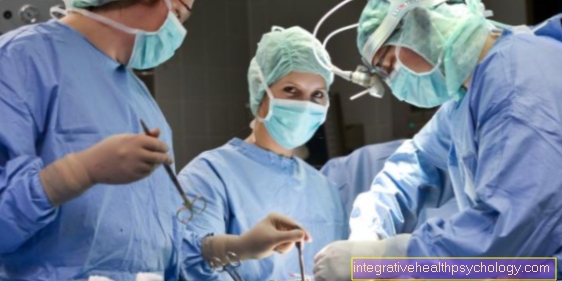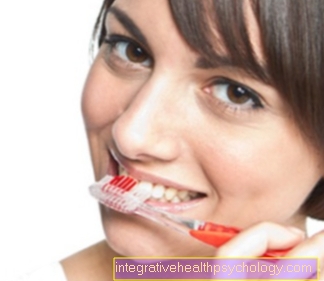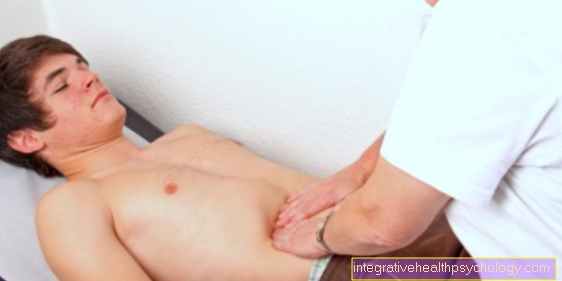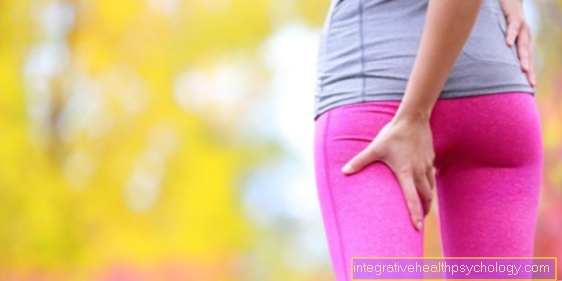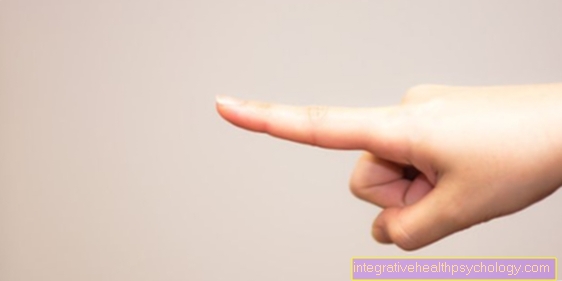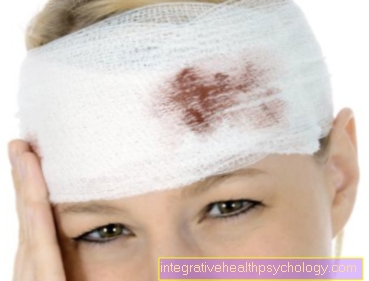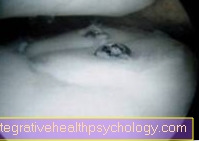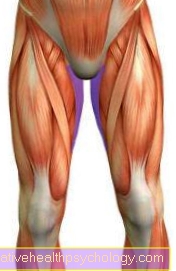Brush teeth
Synonyms
Brush your teeth, teeth cleaning, dental care, floss, toothbrush
introduction
Bacterial plaque is the cause of tooth decay and diseases of the tooth supporting system.
The prophylaxis, i.e. prevention, of these diseases consists in the removal of these deposits. In addition to dental floss, tooth sticks and interdental brushes, toothbrushes and toothpaste in particular are used for this.
Since the deposits sit very firmly on the tooth surface, a certain system is necessary. Various cleaning methods have been developed for this purpose.

What toothbrushing techniques are there?
A distinction is made between different toothbrushing techniques:
-
Horizontal method
-
Charters Method
-
Rotation method
-
"Red-on-white technology" according to Leonard
-
Modified bass technique
-
Modified Stillmann technique
-
Jackson technique
-
KAI method (chewing surfaces - outer surfaces - inner surfaces)
You can find more information here: Toothbrushing techniques - how do I brush best?
The rotation method
The rotation method is particularly suitable for small children. With the row of teeth closed, the toothbrush is placed vertically and circular movements are carried out, with both the upper and lower teeth being captured at the same time. However, the plaque below the gums is not cleaned. Of course, it is also not possible to reach the inner surfaces of the teeth with this method when the teeth are closed.
There are also other cleaning methods. These are, for example, the charter toothbrushing method, relatively complicated and should therefore be shown and practiced in the dental practice. They are also only suitable for special cases.
The red-on-white method
The red to white method of brushing teeth is the most common brushing technique. It is particularly suitable for children, adolescents and adults, for whom the risk of tooth decay is in the foreground. With this method, the bristles of the toothbrush stand vertically on the gums and are moved towards the tooth with slightly circular movements. The advantage of this cleaning technique is that it is easy to learn. The disadvantage is that the plaque below the gums cannot be reached.
The bass method

The Bass method is primarily intended for patients who already have gum pockets, as this method also covers the indentations on the gumline. However, this cleaning technique is more time consuming. With this method, the toothbrush is placed on the tooth at an angle of 45 ° and the gum pockets are cleaned with shaking movements. It is important to ensure that the gums are not injured.
Systematics when brushing your teeth

A systematic approach is necessary in order to achieve a thorough cleaning of the teeth. Right-handed people often start at the back of the lower left jaw to the middle of the row of teeth and then on the right side. The upper jaw usually begins on the right rear and then on the left side. First the outer surfaces are brushed and then the inner surfaces of the teeth. At the end, the chewing surfaces are cleaned. Left-handed people clean in the reverse order.
It is important that everyone develops their own system that they can best cope with. No tooth or surface should be neglected. Even if you are tempted to run around while brushing your teeth, it is better to stand in front of the mirror and check that you can really reach every spot and at the right angle. This self-control and focus is important to maintain oral health over the long term.
Also read: Professional teeth cleaning
Wrong cleaning method
Unfortunately, the wrong cleaning technique is most often used. The toothbrush is guided along the row of teeth with horizontal movements. This so-called "scrubbing" has several disadvantages. The plaque is carried into the interdental space and not removed. Deposits below the gingival margin are not removed and wedge-shaped defects can occur in patients who already have exposed tooth necks. In the long run, cleaning defects occur that damage the tooth and make it more sensitive.
You might also be interested in: Tooth neck is exposed - what to do?
Avoidance of plaster damage
Improperly brushing your teeth can also cause damage. Excessive contact pressure can lead to a breakdown of the bone and thereby expose the tooth necks. The pressure with which the bristles are guided along the tooth should therefore not be more than 200 grams. "Scrubbing", especially with hard bristles, can lead to wedge-shaped defects. Too hard bristles and too high pressure can damage the gums.
How often should the teeth be brushed?
It is recommended to brush your teeth after every meal. However, this is not always possible, but you should always come to at least twice a day.
In the morning, teeth should be brushed after breakfast. With the exception of acidic foods or drinks, such as orange juice, for breakfast. Then the top layer of enamel could be attacked, which is then peeled off during cleaning. Therefore, in these cases, you should clean before breakfast. After dinner, the teeth should be brushed so that bacteria in the plaque cannot attack the enamel during the night.
Duration of brushing your teeth
Depending on which brushing method is used, the duration of brushing your teeth is different. In the literature, a cleaning time of 3 minutes is repeatedly stated. This is a very long time. Experience has therefore shown that the average cleaning time is only 1 minute and less. This is definitely not enough to thoroughly clean every area. Usually the cleaning time seems longer than it actually is, which is why you should look at a clock in order not to overshadow your oral hygiene. The use of an electric toothbrush does not reduce the necessary cleaning time either.
What to think of apps for brushing teeth?
The novelty on the market are apps that are supposed to help brush your teeth so that users have better feedback on how good their own oral hygiene is. Particularly noteworthy are the apps that are specially made for children and are intended to make daily oral care more fun.
There are apps like Playbrush, Cleaning heroes or Brush busters, which combines tooth brushing with an interactive game, where the child brushes their teeth in a playful way by driving away tooth monsters or flying an airplane with brushing movements. The child thus always associates brushing their teeth with an experience that they enjoy doing and even develop a desire to brush their teeth more often and for longer without you noticing. The manufacturer has developed many games to keep it exciting for as long as possible. There is a special reward system for a successful game.
The manual toothbrush is connected to the app by means of an attachment into which any commercially available manual toothbrush can be inserted.
There are also apps for adults that recognize the position of the toothbrush via Bluetooth and help the user to optimize their teeth brushing. The toothbrush recognizes when the user presses too hard while brushing and provides information about this, the app creates an individual toothbrushing program that is tailored to personal needs.
In general, toothbrush apps are a relief for daily dental care, which gives the user feedback on where there are still weak points that can be improved that he does not even notice. Especially for children, these apps are to be rated positively, as they combine the annoying brushing of teeth with a game or an experience and thus create fun, joy and a sense of achievement for children and parents in order to eliminate any aversions. Which app is best for the user or the child should be tested in advance. A consultation with the dentist can also be helpful.
However, one should try beforehand to teach the children how to brush their teeth without apps or mobile phones. You should explain to them exactly why you have to brush your teeth thoroughly and also point out the consequences that arise from neglect. There are good short stories, e.g. from Karius and Bactuswho guide the children and take them on adventures.
Brushing the baby's teeth
As soon as the first milk teeth erupt at around 6 months old, it is advisable to clean them. Brushing your baby's teeth is important even if they are still breastfeeding, as breast milk also contains sugar. Correct dental care begins with the baby. There are special soft toothbrushes for babies with a small brush head that can be used to reach the milk teeth. The baby toothbrush, like the adult toothbrush, must also be replaced at least every two months in order to ensure that the toothbrush performs well. Since milk teeth are less stable, as they contain fewer crystal parts in the enamel layer and this is thinner than the permanent teeth, they must be protected by regular cleaning. By the age of two and a half, in most cases, all twenty milk teeth have erupted, which can quickly become infected with tooth decay if one of the parents regularly consumes fruit juices or sugary foods, unless they are regularly brushed by one of the parents. In addition to special toothbrushes, there is also toothpaste that contains a lower fluoride content especially for small children and is therefore suitable for daily cleaning. Optimally, one should brush baby's teeth at least twice a day with a pea-sized amount.
Learn more about the topic on our main page: Brushing the baby's teeth
Bridges and removable dentures
Dental crowns and dental bridges require special cleaning. The main focus here is on the region of the tooth neck. Bridges should be cleaned with both a toothbrush and dental floss. A special floss dental floss is suitable for this, which can be guided along well below the pontic and thus also clean areas inaccessible to the brush.
The cleaning of the removable dentures is of course carried out outside the mouth, but the remaining teeth are cleaned normally.
Brush without toothpaste?
If you had the choice of not using a toothbrush or toothpaste, the decision would be left with the toothpaste, as the brush is the decisive factor when it comes to teeth cleaning. However, it then depends on a very thorough cleaning with the toothbrush and the use of dental floss or interdental brushes to clean the interdental spaces in order to be able to replace the toothpaste. In general, it is a relief to remove all food residues and coatings and to leave a fresh taste and smell. It is therefore possible that not using toothpaste will result in bad breath.
As an alternative to toothpaste, there are tabs for chewing, which are produced in capsule form. These chewable tablets are particularly suitable for traveling.
Brush without a toothbrush?
Teeth cleaning with a brush without mechanical activity is insufficient. The plaque that adheres to the teeth after eating can only be removed by mechanical removal with a toothbrush. No mouth rinse solution, no mouthwash and not even just toothpaste can be sufficient because they cannot remove these deposits.
The bacteria then have the chance to metabolize the food residues and attack the hard tooth substances. Caries and inflammation of the soft tissues develop more quickly. Without proper cleaning methods with toothbrushes and dental floss, food residues can remain in the spaces between the teeth and serve as food for the bacteria, which produce acids and thus cause lasting damage.
Conclusion: The manual or electrical cleaning of teeth with a toothbrush cannot be replaced and is essential for a healthy oral flora.
Brushing your teeth with home remedies / naturopathy
- with baking powder / baking soda
Baking powder consists of a coarse-grained salt, sodium dihydrogen carbonate, which has a strong abrasive effect when scrubbed with a toothbrush. These abrasions can minimize discoloration and tartar, but they also erase the tooth enamel and thus destroy the protective coating of the tooth. Baking powder or baking soda is therefore not suitable for daily dental care due to its abrasive effect, and use with these materials is therefore not recommended.
The initially lightening effect of the abrasion disappears quickly as soon as the yellow dentin, the dentin, appears. The teeth become more sensitive to heat and cold and, after a while, chewing problems arise.
- with salt
Brushing your teeth with salt has a long tradition, which was considered normal, especially in the time before toothpaste. But the effect of cleaning teeth with silicates becomes apparent after a short time. The teeth are weakened by the structure of the salt. Due to the coarse grains of salt and the rubbing with the toothbrush, the hard tooth substances are gradually removed and the tooth loses its protective coating.
The outer layer of the hard tooth substance, the enamel, is the hardest substance in the human body and cannot be formed again or regenerated. The tooth is getting thinner and thinner and stimuli come closer to the pulp with the nerve and blood vessels in it. This increases the perception of thermal or chemical stimuli and makes the tooth sensitive. Cold drinks and food can then trigger unpleasant cold pain and bacteria damage the tooth more easily. It is therefore not advisable to brush your teeth with salt, as the coarse grains cause lasting damage to the tooth and are therefore not suitable for daily dental care.
- with coconut oil
Some people nowadays avail themselves of coconut oil because it is said to be beneficial for dental health. Coconut oil is already used in naturopathy due to its antibacterial, antiviral and antifugal effects. The lauric acid it contains causes plaque to dissolve - but also of the hard tooth substance. The tooth enamel becomes thinner and thinner through regular use, so that the protective coating of the tooth decreases and it becomes sensitive to stimuli such as heat, cold or sweets. The teeth appear slightly lightened by the removal, but one must consider that the layers of the tooth enamel that have been removed can no longer be reproduced.
At best, coconut oil can help to remove bacteria on the soft tissues such as the tongue, which cause unpleasant bad breath and thus create a fresh mouthfeel.
You can get to the main article here: Brush your teeth with coconut oil
- with activated carbon
Due to its binding properties, activated carbon is used to clean teeth in remote regions of the world. It still has abrasive properties and removes the top layer of the plaque; if too much pressure is applied, the hard tooth substance is also removed. However, activated charcoal is not suitable for daily tooth cleaning, as the granules it contains are so coarse that they remove too much enamel and weaken the tooth with frequent use. It is therefore advisable to use activated charcoal only a few times a month to loosen discoloration caused by coffee, nicotine or red wine.
- with healing earth
Healing earth is a powder that is obtained from ice-age loess deposits and is mixed with a liquid for use. It is very popular in naturopathy, but as a dentifrice it is classified as similar to activated charcoal or baking powder. The healing earth contains coarse grains, aluminum silicates, which remove the hard tooth substances and thus permanently damage the teeth. Healing earth should therefore not be used to whiten teeth.
- with whiting chalk
Whipped chalk is the result of limescale degradation and is known as a component of every commercially available toothpaste. Whipped chalk is an alternative to conventional toothpaste in naturopathy. It consists of calcium carbonate and is supposed to clean the oral cavity effectively - however, there are no long-term studies or scientific findings about this product as a substitute. Since the use of this natural product lacks fluoride, dentists advise against using the whiting chalk.


